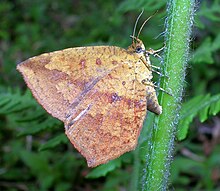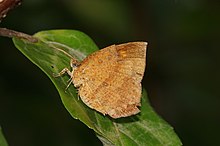
Actias selene, the Indian moon moth or Indian luna moth, is a species of saturniid moth from Asia. It was first described by Jacob Hübner in 1807. This species is popular among amateur entomologists and is often reared from eggs or cocoons that are available from commercial sources. They fly mainly at night.

Ideopsis vulgaris, the blue glassy tiger, is a butterfly that belongs to the crows and tigers, that is, the danaid group of the brush-footed butterflies family.

Smerinthus ocellatus, the eyed hawk-moth, is a European moth of the family Sphingidae. The species was first described by Carl Linnaeus in his 1758 10th edition of Systema Naturae.

The map-winged swift is a moth belonging to the family Hepialidae and has a patchy distribution throughout Eurasia. The species was first described by Charles De Geer in 1778. It was previously placed in the genus Hepialus and some references still place it there.

Psimada is a monotypic moth genus of the family Noctuidae. Its only species, Psimada quadripennis, is found in the Indian subregion, southern China, Taiwan, Myanmar, Thailand, Sri Lanka, the Andaman Islands, Sundaland, Sulawesi and Seram. Both the genus and species were first described by Francis Walker in 1858.

Thyas honesta is a species of moth of the family Noctuidae first described by Jacob Hübner in 1824. It is found in the Indian subregion, Myanmar, Thailand, Peninsular Malaysia, Sumatra, Sri Lanka, Borneo and on the Philippines.

Ophiusa disjungens, the guava moth, is a moth of the family Erebidae. The species was first described by Francis Walker in 1858. It is found in south-east Asia and the south Pacific, including Thailand, Japan, Tonga and New South Wales and Queensland. The adult is a fruit piercer.

Sasunaga tenebrosa is a moth of the family Noctuidae first described by Frederic Moore in 1867. It is found from the Indian subregion, Sri Lanka to Sundaland, the Philippines and Sulawesi.
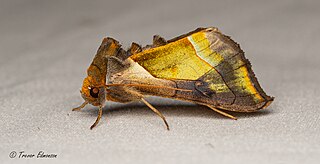
Diachrysia balluca, commonly known as the green-patched looper or hologram moth, is a moth of the family Noctuidae. The species was first described by scientific illustrator Carl Geyer in 1832.
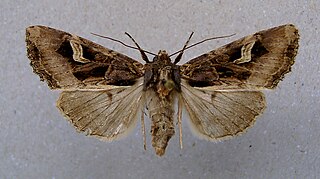
The flame brocade is a moth of the family Noctuidae. The nominate subspecies T. f. flammea is found in Europe, mostly in the Mediterranean area up to Normandy. It is also found on the Channel Islands and it has spread to Southern England and Ireland. It is found in the Maghreb as the subspecies T. f. vividior. This also occurs in parts of Spain. The species lives primarily in dry areas, on warm slopes, grassy scrubland and in karstic oak.

Argina astrea, the crotalaria podborer, is a moth of the family Erebidae. The species was first described by Dru Drury in 1773. It is found in eastern Africa, southern Asia of India, Sri Lanka, Maldives and Indo-Australia, including the Pacific Islands and Australia.

Trabala vishnou, the rose-myrtle lappet moth, is a species of moth in the family Lasiocampidae. It is found in southern Asia, including Pakistan, India, Bangladesh, Thailand, Sri Lanka, Myanmar, China, Japan, Taiwan, Vietnam, and Indonesia. Four subspecies are recognized.

Condica dolorosa is a moth of the family Noctuidae. It is found in the Indo-Australian tropics, including Borneo, Hawaii, Hong Kong, India, Sri Lanka, Taiwan and Queensland in Australia.
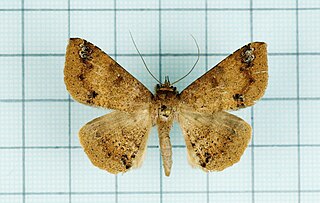
Ericeia inangulata, the sober tabby, is a moth in the family Erebidae. The species was first described by Achille Guenée in 1852. It is found in the Indo-Australian tropics of China, India, Sri Lanka, Myanmar, and the Marianas and Carolines, Fiji, Vanuatu, New Caledonia and Samoa.

Striglina scitaria, the daincha leaf webber, is a species of moth of the family Thyrididae described by Francis Walker in 1862. It is found in Taiwan, Japan, India, Sri Lanka, Maldives, Myanmar, the Andamans, Borneo, New Guinea, Fiji and Australia. It is a major pest which mainly attacks legume crops.

The palmflies are a common Asian butterfly genus found from India to the Solomon Islands. The caterpillars mimic leaves which they feed on. The adults mimic certain species.

Spodoptera picta, the lily caterpillar, is a moth of the family Noctuidae. It was described by Félix Édouard Guérin-Méneville in 1838. It is found in from India, South-east Asia and Japan through Indonesia and the western part of South Pacific ocean to Fiji.
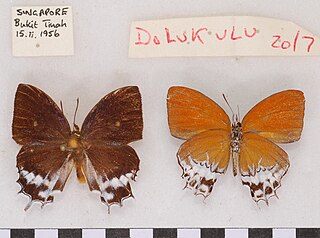
Eooxylides tharis, the branded imperial, is a butterfly in the family Lycaenidae. It was described by Carl Geyer in 1837. It is found in the Indomalayan realm.
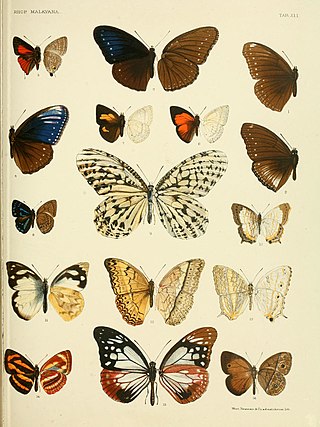
Appias pandione is a butterfly in the family Pieridae. It was described by Carl Geyer in 1832. It is found in the Indomalayan realm.

Phalaenoides tristifica, the willow-herb day, is a moth of the family Noctuidae that is native to southeastern Australia. The species was first described by Jacob Hübner in 1818.
